
Sexual cannibalism is when an animal, usually the female, cannibalizes its mate prior to, during, or after copulation. It is a trait observed in many arachnid orders and several insect and crustacean clades. Several hypotheses to explain this seemingly paradoxical behavior have been proposed. The adaptive foraging hypothesis, aggressive spillover hypothesis and mistaken identity hypothesis are among the proposed hypotheses to explain how sexual cannibalism evolved. This behavior is believed to have evolved as a manifestation of sexual conflict, occurring when the reproductive interests of males and females differ. In many species that exhibit sexual cannibalism, the female consumes the male upon detection. Females of cannibalistic species are generally hostile and unwilling to mate; thus many males of these species have developed adaptive behaviors to counteract female aggression.
Nigorella is a genus of jumping spiders that was first described by Wanda Wesołowska & Beata Tomasiewicz in 2008. The name is described as "an arbitrary combination of letters", feminine in gender. Three previously species described were transferred to the genus: Pachypoessa albimana as N. albimana, Philaeus manicus as N. manica, and Euophrys plebeja as N. plebeja. Subsequently it was discovered that Euophrys plebeja was a nomen dubium, with no known type specimen.
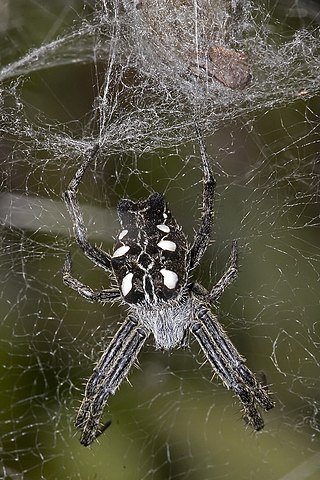
Cyrtophora citricola, also known as the tropical tent-web spider, is an orb-weaver spider in the family Araneidae. It is found in Asia, Africa, Australia, Costa Rica, Hispaniola, Colombia, and Southern Europe and in 2000, it was discovered in Florida. C. citricola differs from many of its close relatives due its ability to live in a wide variety of environments. In North America and South America, the spider has caused extensive damage to agricultural operations.

Darwin's bark spider is an orb-weaver spider that produces the largest known orb webs, ranging from 900 to 28,000 square centimetres, with bridge lines spanning up to 25 metres (82 ft). The spider was discovered in Madagascar in the Andasibe-Mantadia National Park in 2009. Its silk is the toughest biological material ever studied. Its tensile strength is 1.6 GPa. The species was named in honour of the naturalist Charles Darwin on November 24, 2009—precisely 150 years after the publication of The Origin of Species.
This glossary describes the terms used in formal descriptions of spiders; where applicable these terms are used in describing other arachnids.

Socca pustulosa is a Orb-weaver spider species in the family Araneidae, and it was first described by a French scientist Charles Athanase Walckenaer in 1841 from Tasmania, Australia, but later on when Walckenaer examined the specimen collected from New Zealand and renamed it as a different species- Epeira verrucosa. Until 1917, Dalmas reviewed the Australian pustulosa and New Zealand verrucosa and realized they were the same species. Although S. pustulosa has been accepted for some time in the genus of Eriophora, the evidence supporting its placement within this genus were not fully convincing. Therefore, an alternative view was proposed in 2022- a new genus established to accommodate pustulosa along with 11 other spider species from Australia; the diagnostic test based on haplotype analysis and systematic morphology study by arachnologists and found the anatomical features of male pedipalp terminal apophysis differs from other orb-web species.
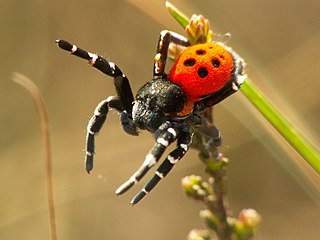
Sexual selection in spiders shows how sexual selection explains the evolution of phenotypic traits in spiders. Male spiders have many complex courtship rituals and have to avoid being eaten by the females, with the males of most species survive a few matings, and having short life spans.
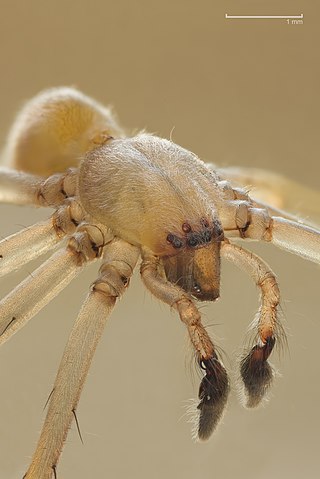
The two palpal bulbs – also known as palpal organs and genital bulbs – are the copulatory organs of a male spider. They are borne on the last segment of the pedipalps, giving the spider an appearance often described as like wearing boxing gloves. The palpal bulb does not actually produce sperm, being used only to transfer it to the female. Palpal bulbs are only fully developed in adult male spiders and are not completely visible until after the final moult. In the majority of species of spider, the bulbs have complex shapes and are important in identification.
Utivarachna arcuata is a species of spiders in the family Trachelidae found only in Yunnan Province of China. It was described in 2014 by Li Zhao and Xian-Jin Peng. Adult males reach 3.65 millimetres (0.144 in) to 5.1 millimetres (0.20 in) long, while females can be 5.85 millimetres (0.230 in) to 6.65 millimetres (0.262 in) long. It closely resembles the Thailand species Utivarachna rama, but there are several distinct differences. The back part of the palpal bulb is semi-spherical, the tip of the embolus is only about a fifth as long as the basal part, the tibial apophysis is slightly tapered, the copulatory opening is on the back of the epigyne, the back bursae are longer and thinner, and the connecting ducts are spaced farther apart. In Latin, the term "arcuata" means "curved". This name refers to the curved shape of the bottom part of embolus, the small, thin extension on the palpal bulb of the pedipalp.
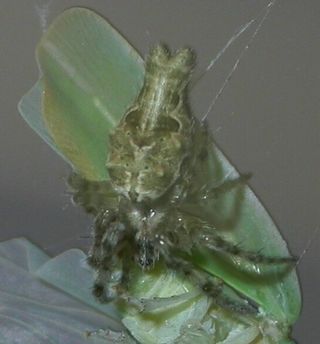
Allocyclosa is a genus of orb weaver spiders that contains only one species, Allocyclosa bifurca. It was first described in 1887 by McCook under the name Cyrtophora bifurca, and was transferred to its own genus in 1999. It is the only Cyclosa species north of Mexico to have a forked tail, hence the name bifurca, Latin for "two-forked". The forked abdomen, bearing two humps shaped like the letter M, is a defining feature in both males and females, though it is similar to features present in certain Cyrtophora species. Both sexes are a transparent green color, though only females have an area of red on their underside between the epigynum and the spinnerets. Females are nearly thirty percent larger than males, ranging from five to nine millimeters, while males range from two to three millimeters. Males are very uncommon. In a 1977 study by Levi, only two of the nearly 350 specimens that were positively identified as Cyrtophora bifurca were males. This is a very odd distribution, and it has been posed that females of the species, which have less prominent genitalia relative to other members of the orb-weaver family, may be parthenogenic, or able to reproduce without the help of males. Like other members of Araneidae, these spiders create orb webs, six to eight inches in diameter, but apply a unique form of protective mimicry. Females sit in the middle of a vertical row of web decoration, with egg sacs above and wrapped prey below. Because they all have a similar color and shape, it is difficult to discern between the egg sacs, the wrapped prey, and the spider itself.

Langona pilosa is a species of jumping spider in the genus Langona that lives in Namibia. The male was first described by Wanda Wesołowska in 2006 and the female in 2011. The spider is small with a cephalothorax between 2.2 and 3.1 mm long and a abdomen between 2.1 and 3.5 mm. The female is larger than the male. The spider has a brown carapace that has two white stripes on its back, a large dark patch on its yellowish abdomen, a black eye field and the toothless chelicerae typical of the genus. The male can be distinguished from others in the genus by the existence of tufts around the palpal bulb, after which it is named, and the very long and thin tibial apophysis. The female has copulatory organs that resemble Langelurillus ignorabilis but differ in the design of the seminal ducts.
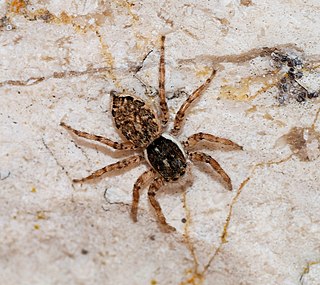
Menemerus animatus is a species of jumping spider in the genus Menemerus that lives across the Mediterranean Basin and into the Afrotropical realm. The species was first described in 1876 by Octavius Pickard-Cambridge based on an example from Egypt. It has subsequently been found living across many countries from Algeria to Greece and Senegal to Yemen. It prefers living in sandy environments.
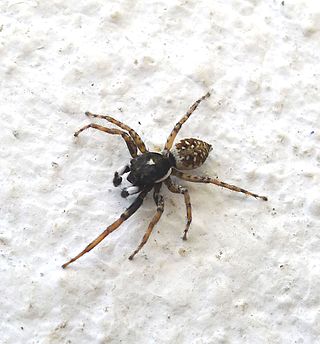
Menemerus patellaris is a species of jumping spider in the genus Menemerus that lives in Yemen. The spider was first described in 2007 by Wanda Wesołowska and Antonius van Harten. The spider is medium sized with a carapace that is typically 2.6 mm (0.10 in) long and abdomen between 2.9 mm (0.11 in) long. The carapace is brown with white stripes on the edges. The abdomen is yellowish-beige, while the legs are yellow. The spider is hard to distinguish from others in the genus without a study of its copulatory organs. It has a very short embolus and a distinctive furrow in its tegulum dividing a sac of tissue used in copulation called the haematodocha. In addition to the spike, or apophysis on its tibia, it has another one on the patellar, the section between the tibia and the palpal bulb.

Afraflacilla eximia is a species of jumping spider in the genus Afraflacilla that lives in Zimbabwe. The spider was first described in 2000 by Wanda Wesołowska and Anthony Russell-Smith. Originally allocated to the genus Pseudicius, it was moved to its current name by Jerzy Prószyński in 2016. The spider is small, with a brown carapace that is typically 2.1 mm (0.08 in) long and a russet-brown abdomen that is typically 2.8 mm (0.11 in) long. It has a black eye field and brown legs. It has distinctive copulatory organs that enables it to be distinguished from other species in the genus, particularly the related Afraflacilla braunsi and Afraflacilla roberti. The male has a particularly long tibial apophysis, or projection on its palpal tibia, and longer embolus. The female has not been described.

Nephilidae is a spider family commonly referred to as golden orb-weavers. The various genera in Nephilidae were formerly placed in Tetragnathidae and Araneidae. All nephilid genera partially renew their webs.
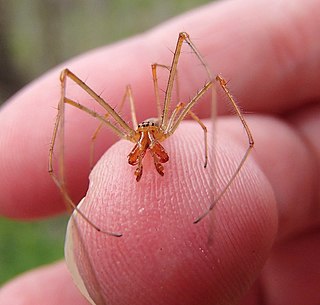
Tetragnatha versicolor is a species of long-jawed orb weaver in the spider family Tetragnathidae. It is found throughout North America, Canada, Central America, and Cuba, but are most common in the United States. T. versicolor is heavily concentrated in New England and the west coast in states like California and Washington. T. versicolor is considered a habitat generalist, and can thrive in many different environments. While they can be found in places like Grasslands, Wetlands, Forests, etc., they prefer dryer areas like normal trees and shrubs. Unlike other spiders in the genus Tetragnatha, T. versicolor will rarely reside near aquatic environments. T. versicolor will typically be colored dark yellow or pale orange and average around 5 mm for males and 6.5 mm for females in length, which is very small for a spider. They are much longer than they are wide, making them very distinct. In addition, T. versicolor can be distinguished from other spiders in Tetragnatha by the distinct separation of the anterior/posterior eyes and the appearance of their reproductive organs. As an orb weaver spider, T. versicolor creates a web to hunt for prey. It will wait at night for prey to stumble into its web and use vibrational signals throughout the web to sense trapped prey. In terms of mating behavior, T. versicolor lacks a distinct courting ritual and will mate with any others in the proximity. Mating behavior is heavily affected by female mating history. In terms of interactions with humans, the bite of T. versicolor is venomous, but not known to cause significant harm.
Agelenopsis pennsylvanica, commonly known as the Pennsylvania funnel-web spider or the Pennsylvania grass spider, is a species of spider in the family Agelenidae. The common name comes from the place that it was described, Pennsylvania, and the funnel shape of its web. Its closest relative is Agelenopsis potteri.

Leucauge mariana is a long-jawed orb weaver spider, native to Central America and South America. Its web building and sexual behavior have been studied extensively. Males perform several kinds of courtship behavior to induce females to copulate and to use their sperm.

Cyrtarachne inaequalis is a species of spider in the orb-weaver spider family Araneidae, found in India, Myanmar, China and Korea. Spiders in the genus Cyrtarachne construct "spanning-thread webs" rather than the more typical orb webs of the family Araneidae. These webs have a small number of radii and instead of a tight spiral of sticky threads, the sticky spanning threads are widely spaced and do not form a spiral. When prey is caught on one of the spanning threads, one end comes loose, and the prey, often a moth, dangles from the other end until hauled in by the spider.

Pasilobus hupingensis is a species of spider in the orb-weaver spider family Araneidae, found in China and Japan. Females of the genus Pasilobus construct "spanning-thread webs" with only two sectors, making them appear triangular. Widely spaced threads with sticky drops span the three radii of these webs. One end is attached in such a way that it readily breaks free. When a prey item is caught on one of these threads, the line parts at this end and the prey hangs from the web until it is hauled up by the spider.


















